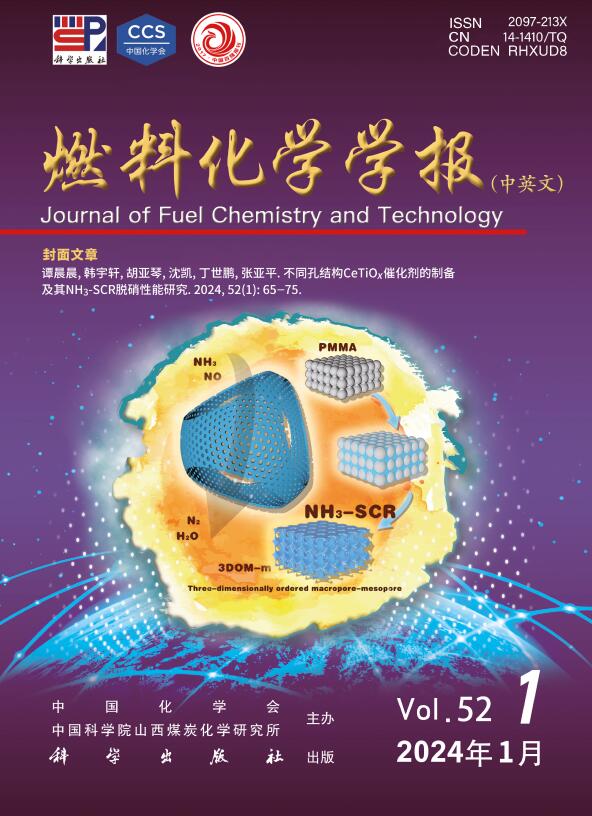用ZSM-22/ZSM-48复合沸石调节正十二烷加氢异构的异构体分布
Q3 Energy
引用次数: 0
摘要
ZSM-22和ZSM-48分子筛的拓扑结构不同,在正构烷烃的加氢异构反应中表现出不同的催化性能,特别是在生成的异构体分布上。本文采用机械混合法和二次水热合成法合成了ZSM-22/ZSM-48复合沸石;采用XRD、SEM、NH3-TPD和N2吸附等方法对沸石样品进行了表征,并比较研究了其催化正十二烷加氢异构化的性能。结果表明:ZSM-22/ZSM-48复合分子筛具有两种分子筛的综合性能;它们的比表面积、微孔体积、微孔面积和酸性介于ZSM-22和ZSM-48分子筛之间。对于正十二烷的加氢异构反应,单支异十二烷产物中2-甲基十一烷的比例比Pt/ZSM-22/ZSM-48- s复合分子筛高19% ~ 44%,比Pt/ZSM-48分子筛高20%左右,比Pt/ZSM-22分子筛低10%左右;此外,Pt/ZSM-22/ZSM-48- s单支异十二烷产物中5-甲基十一烷的比例为23% ~ 42%,比Pt/ZSM-22高8%左右,比Pt/ZSM-48低13%左右。结果表明,Pt/ZSM-22/ZSM-48复合分子筛催化剂中两种不同拓扑结构的沸石(即ZSM-22和ZSM-48)的质量比可以调节正构烷烃加氢异构化产物的分布。本文章由计算机程序翻译,如有差异,请以英文原文为准。
Modulating isomers distribution of n-dodecane hydroisomerization by using ZSM-22/ZSM-48 composite zeolite
ZSM-22 and ZSM-48 zeolites are different in their topological structure and show distinct catalytic performance in the hydroisomerization of n-alkanes, especially in the distribution of produced isomers. In this work, ZSM-22/ZSM-48 composite zeolites are synthesized by the mechanical mixing method and the secondary hydrothermal synthesis; the zeolite samples are characterized by XRD, SEM, NH3-TPD and N2 sorption and their catalytic performance in the hydroisomerization of n-dodecane was comparatively investigated. The results indicate that the ZSM-22/ZSM-48 composite zeolites exhibit combined properties of the two individual zeolites; their surface area, micropore volume, micropore area and acidity lie between those of the single ZSM-22 and ZSM-48 zeolites. For the hydroisomerization of n-dodecane, the percentage of 2-methylundecane in the monobranched iso-dodecane product is 19%–44% over the Pt/ZSM-22/ZSM-48-S composite zeolite, which is about 20% higher than that over Pt/ZSM-48 and about 10% lower than that over Pt/ZSM-22; in addition, the percentage of 5-methylundecane in the monobranched iso-dodecane products over Pt/ZSM-22/ZSM-48-S is 23%–42%, which is about 8% higher than that over Pt/ZSM-22 and about 13% lower than that over Pt/ZSM-48. The results suggest that the distribution of the isomer products of n-alkanes hydroisomerization can be regulated by adjusting the mass ratio of two zeolites of different topological structures (i.e., ZSM-22 and ZSM-48) in the Pt/ZSM-22/ZSM-48 composite zeolite catalyst.
求助全文
通过发布文献求助,成功后即可免费获取论文全文。
去求助
来源期刊

燃料化学学报
Chemical Engineering-Chemical Engineering (all)
CiteScore
2.80
自引率
0.00%
发文量
5825
期刊介绍:
Journal of Fuel Chemistry and Technology (Ranliao Huaxue Xuebao) is a Chinese Academy of Sciences(CAS) journal started in 1956, sponsored by the Chinese Chemical Society and the Institute of Coal Chemistry, Chinese Academy of Sciences(CAS). The journal is published bimonthly by Science Press in China and widely distributed in about 20 countries. Journal of Fuel Chemistry and Technology publishes reports of both basic and applied research in the chemistry and chemical engineering of many energy sources, including that involved in the nature, processing and utilization of coal, petroleum, oil shale, natural gas, biomass and synfuels, as well as related subjects of increasing interest such as C1 chemistry, pollutions control and new catalytic materials. Types of publications include original research articles, short communications, research notes and reviews. Both domestic and international contributors are welcome. Manuscripts written in Chinese or English will be accepted. Additional English titles, abstracts and key words should be included in Chinese manuscripts. All manuscripts are subject to critical review by the editorial committee, which is composed of about 10 foreign and 50 Chinese experts in fuel science. Journal of Fuel Chemistry and Technology has been a source of primary research work in fuel chemistry as a Chinese core scientific periodical.
 求助内容:
求助内容: 应助结果提醒方式:
应助结果提醒方式:


